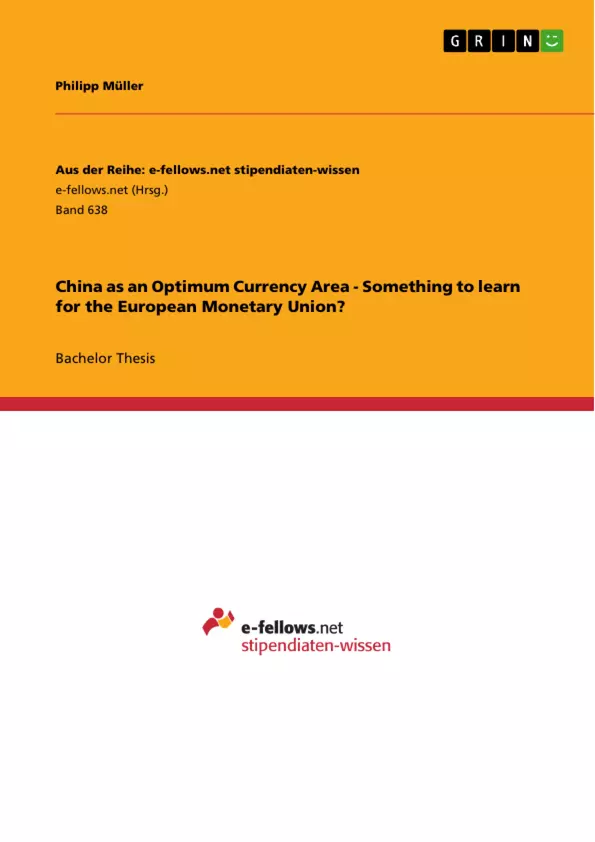The main objective of this thesis is to find out whether the PRoC is an OCA and what does it mean for the EMU. Based on the differences between the two currency areas, I would like to discuss whether there are any lessons that are worthwhile to be learned from the PRoC by the EMU to face better current and future crises. Therefore, the thesis is organized as follows. Section 2 provides an overview of the theoretical framework which this bachelor thesis is based on, namely the theory of OCA. Section 3 explains the methodology of my empirical study and describes the used data set. Section 4 examines the PRoC as an OCA. I evaluate each criterion on the basis of my own empirical study or available literature. After I briefly analyzed the Euro Crisis in section 5, I compare the EMU with the PRoC on the basis of OCA criteria followed by a discussion why there are differences and whether the EMU could improve conditions as a common currency area by learning from the PRoC. Section 6 concludes my findings and relate them to my opening questions of this introduction.
Inhaltsverzeichnis (Table of Contents)
- ABBREVIATIONS.
- 1. INTRODUCTION
- 2. THEORETICAL FRAMEWORK..
- 2.1. THE CLASSICAL THEORY OF OCA
- 2.2. THE NEW ENDOGENEITY APPROACH OF OCA
- 2.3. CRITIQUE
- 3. DATA SET AND METHODOLOGY.
- 3.1. SELECTION OF OCA CRITERIA.......
- 3.2. KEY FIGURES: CALCULATION, SOURCES AND CHARACTERISTICS...
- 4. OCA CHARACTERISTICS OF THE PROC
- 4.1. MARKET SIZE..
- 4.2. PRODUCTION DIVERSIFICATION
- 4.3. STABILITY AND PREDICTABILITY OF PRICES
- 4.4. PRICE FLEXIBILITY
- 4.5. WAGE FLEXIBILITY
- 4.6. INTERPROVINCIAL TRADE...
- 4.7. PRODUCTION SIMILARITY
- 4.8. LABOR MOBILITY
- 4.9. CAPITAL MOBILITY.
- 4.10. CONVERGENCE OF PRICES
- 4.11. SYNCHRONICITY OF BUSINESS CYCLES
- 4.12. FISCAL TRANSFERS
- 4.13. SUMMARY: IS THE PROC AN OCA?
- 5. ARE THERE ANY LESSONS FOR THE EMU?
- 5.1. PROBLEMS OF THE EMU AS A COMMON CURRENCY AREA AND ITS CAUSES.
- 5.2. WHAT ARE THE CRUCIAL DISTINCTIONS BETWEEN THE EMU AND THE PROC AS COMMON CURRENCY AREAS?
- 5.3. IS THERE SOMETHING TO LEARN FOR THE EMU?...
- 6. CONCLUSION
Zielsetzung und Themenschwerpunkte (Objectives and Key Themes)
This bachelor thesis aims to determine whether the People's Republic of China (PROC) is an Optimum Currency Area (OCA) and what implications this has for the European Monetary Union (EMU). By analyzing the differences between the two currency areas, the thesis seeks to explore whether the EMU can learn any valuable lessons from the PROC to better address current and future crises.
- The theoretical framework of Optimum Currency Areas.
- The empirical characteristics of the PROC as an OCA.
- Comparison of the EMU and PROC based on OCA criteria.
- Identification of potential lessons for the EMU from the PROC's experience.
- The implications of the findings for the future stability of the EMU.
Zusammenfassung der Kapitel (Chapter Summaries)
- Chapter 1: Introduction: The chapter introduces the research question, highlighting the similarities and differences between the PROC and the EMU. It explores the relevance of examining the PROC as an OCA to understand and potentially mitigate the Euro Crisis.
- Chapter 2: Theoretical Framework: This chapter provides a detailed explanation of the theory of Optimum Currency Areas, outlining the classical and new endogenous approaches. It also critically analyzes the theory, addressing its limitations and challenges.
- Chapter 3: Data Set and Methodology: This chapter describes the selection criteria for evaluating the OCA characteristics and the data used in the empirical study. It also outlines the methodology employed for data analysis.
- Chapter 4: OCA Characteristics of the PROC: This chapter examines the PROC in relation to each of the OCA criteria, drawing on both empirical data and available literature. It analyzes market size, production diversification, price stability, price flexibility, wage flexibility, interprovincial trade, production similarity, labor mobility, capital mobility, convergence of prices, synchronicity of business cycles, fiscal transfers, and ultimately assesses whether the PROC qualifies as an OCA.
- Chapter 5: Are There Any Lessons for the EMU?: This chapter analyzes the problems faced by the EMU as a common currency area, identifying the causes of these challenges. It compares the EMU and the PROC based on OCA criteria and discusses the differences between the two currency areas. The chapter explores the potential for the EMU to learn from the PROC's experience and improve its stability as a common currency area.
Schlüsselwörter (Keywords)
This thesis focuses on the key concepts of Optimum Currency Areas (OCA), examining the theoretical framework and applying it to the case of the People's Republic of China (PROC). The research explores the economic characteristics of the PROC as an OCA and compares them to those of the European Monetary Union (EMU), analyzing the potential lessons the EMU could learn from the PROC's experience. The study also examines the Euro Crisis and its implications for the sustainability of the EMU as a common currency area.
- Quote paper
- Philipp Müller (Author), 2012, China as an Optimum Currency Area - Something to learn for the European Monetary Union?, Munich, GRIN Verlag, https://www.grin.com/document/208485



